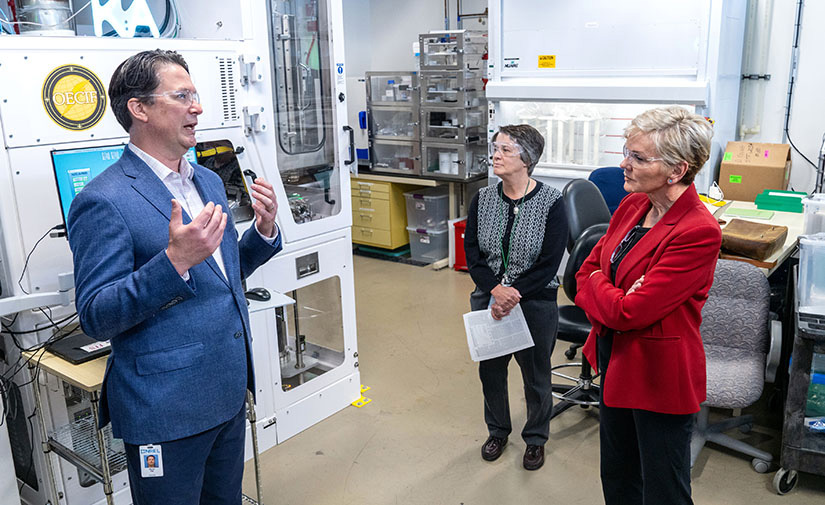News: Photovoltaics
27 October 2023
The US Department of Energy’s (DOE’s) National Renewable Energy Laboratory (NREL) says that it has been able to extract some extra efficiency out of its solar cells through careful design of the materials in the cell stack (Kevin Schulte, John Simon, Myles Steiner and Aaron Ptak, ‘Modeling and Design of III-V Heterojunction Solar Cells for Enhanced Performance’, Cell Reports Physical Science vol 4, issue 9, 20 September 2023, p101541).
Relying on both computational and experimental studies, the researchers grew a gallium arsenide (GaAs) heterojunction solar cell using dynamic hydride vapor phase epitaxy (D-HVPE) with a certified efficiency of 27%, a record for a single-junction GaAs cell grown using this technique.
The research is the latest effort by NREL researchers to make III-V solar cells more affordable for terrestrial applications rather than the more established space applications. D-HVPE offers the potential to be a lower-cost method of synthesizing these cells compared with incumbent techniques.

Picture: NREL senior scientist Aaron Ptak provides an overview of the D-HVPE lab to Secretary of Energy Jennifer Granholm (right) and Nancy Haegel, director of the National Center for Photovoltaics at NREL. (Photo by Werner Slocum, NREL).
The research provides a roadmap to improving the performance of solar cells via optimization of the doping and bandgap of the emitter device layer to minimize the impact of defects on device efficiency. The results are theoretically applicable to materials beyond III-Vs that use heterojunctions such as silicon, cadmium telluride, or perovskites.
“With whatever method you choose to make them, solar cells will always contain some defects thanks to entropy. By using a heterojunction structure, with carefully designed emitter properties, you can minimize the adverse impact of these defects on efficiency, even though you haven’t done anything to reduce their concentration,” says Kevin Schulte of NREL’s High-Efficiency Crystalline Photovoltaics group. “Furthermore, the relative efficiency improvement scales with defect concentration. While the baseline D-HVPE cell already had a high efficiency, a device that had a higher defect concentration would receive a higher relative efficiency boost using the methods described in the paper.”
Along with the GaAs base layer, the solar cell relied on an emitter layer of gallium indium arsenide phosphide (GaInAsP) to make up the heterojunction. Researchers modeled the effect of varying the zinc doping density and bandgap of the emitter layer, which is realized by varying the relative concentrations of gallium, indium, arsenic and phosphorus during layer growth, on cell efficiency. The modeling identified optimal choices for these two parameters that maximize device efficiency. The researchers then synthesized cells using the guidance of the modeling and achieved model-predicted efficiency enhancements. The rear heterojunction solar cell that served as a baseline used an emitter consisting of GaInP and had a reported efficiency of 26%. By reducing the doping in the emitter and changing its composition from GaInP to the lower-bandgap GaInAsP, the efficiency increased to 27% even though the rest of the device was exactly the same.
The benefits of heterojunctions are generally known, although experimental demonstrations of III-V heterojunctions are limited to a handful of combinations, the researchers note. “We took this concept that was known but not quantified this way and mapped it out,” Schulte says. “We showed the modeling matches what we see experimentally, showing that it is a powerful tool for solar cell design.”
www.cell.com/cell-reports-physical-science/
- SEO Powered Content & PR Distribution. Get Amplified Today.
- PlatoData.Network Vertical Generative Ai. Empower Yourself. Access Here.
- PlatoAiStream. Web3 Intelligence. Knowledge Amplified. Access Here.
- PlatoESG. Carbon, CleanTech, Energy, Environment, Solar, Waste Management. Access Here.
- PlatoHealth. Biotech and Clinical Trials Intelligence. Access Here.
- Source: https://www.semiconductor-today.com/news_items/2023/oct/nrel-271023.shtml



